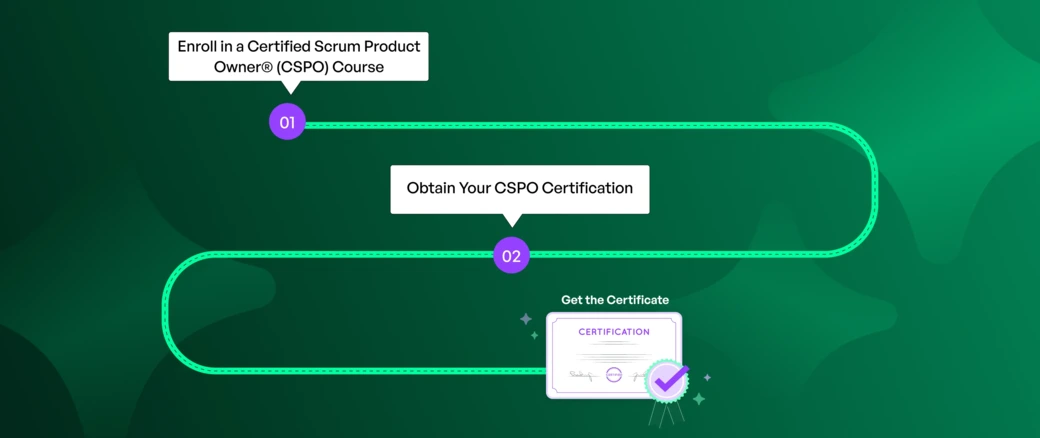A Certified Scrum Product Owner is a person who has received training from a Certified Scrum Trainer in the practices, principles, rules, tools and techniques of the Scrum framework to allow them to play the role of a Scrum Product owner in a team.
This training is perfect for people with an entrepreneurial mindset who wants to build superior products, collaborate with stakeholders management and comes up with novel ideas for solving problems. One of the central tenets of CSPO learning objectives is the flexibility with which you should be able to deal with any challenge that comes your way.
For example, if your client changes the expectation for the outcome of the project while the project is ongoing, you should be able to use the principles of the CSPO learning objectives to accommodate this changed goal.
Your role will be to set objectives for the team, define a vision for the project, set realistic targets for the team to achieve as well as prioritize product backlogs to accomplish the goal.
The Scrum Product Owner has to know and embody the CSPO learning objectives in their roles and while managing their projects.
Here are the outlines of the 5 CSPO learning objectives.
1. Undertaking The Role Of A Product Owner
Understand the responsibilities and expectations associated with the Product Owner role and responsibilities, including managing the product backlog, defining the product vision, and ensuring the development team delivers value to stakeholders.
2. Advanced Purpose and Strategy
Develop the ability to articulate a clear product strategy that aligns with business objectives and customer needs. Learn to create and communicate a compelling product vision guiding development.
3. Empathizing with Customers and Users
Gain insights into customer behaviours and needs through user interviews, personas, and journey mapping. Use this understanding to inform product decisions and prioritise features that deliver maximum value.
4. Advanced Product Assumption Testing
Learn to validate product assumptions through experiments, prototypes, and feedback loops. This approach helps reduce risks and ensure the product meets user expectations.
Also Read: Product Planning Process
5. Working with the Product Backlog
Master the skills required to effectively manage the product backlog, including writing clear user stories, prioritising items based on value, and refining the backlog to reflect changing requirements.
Additional CSPO Learning Objectives
1. Developing Product Owner Core Competencies:
Enhancing decision-making, leadership, and communication skills to fulfil the Product Owner role effectively.
2. Descriptive Purpose:
Learning to describe and communicate the product's purpose and strategic direction to stakeholders and the development team.
Why to Go for CSPO Certification in 2025
High Demand for Skilled Product Owners: Organisations increasingly seek professionals who can effectively manage product development in agile settings.
Enhanced Career Opportunities: CSPO certification opens doors to advanced roles such as Senior Product Owner, Product Manager, and Agile Coach.
Improved Product Outcomes: Certified Product Owners are equipped to make informed decisions that lead to successful product deliveries.
Global Recognition: Scrum Alliance certifications are recognised worldwide, adding credibility to your professional profile.
Access to a Professional Community: Membership with Scrum Alliance provides ongoing learning opportunities and connections with other agile professionals.
How to Accomplish These CSPO Learning Objectives?
1. Enrol in a CSPO Course:
Select a training provider approved by the Scrum Alliance that covers CSPO learning objectives.
2. Participate in Interactive Training:
Engage in workshops and exercises that simulate real-world scenarios, enhancing your understanding of the Product Owner role.
3. Apply Learnings Practically:
Implement the concepts learned during the course in your professional environment to reinforce your skills.
4. Leverage Scrum Alliance Resources:
Utilise the tools and community support Scrum Alliance provides to continue your professional development.
Conclusion
Achieving CSPO Certification in 2025 positions you at the forefront of agile product development. By mastering the CSPO learning objectives, you can deliver products that meet customer needs and drive business success. The certification enhances your skill set and connects you with a global community dedicated to agile excellence. Whether you want to lead innovation or strengthen product outcomes, the CSPO learning objectives set you up for success in a fast-evolving market.







 In 2025, becoming a Certified Scrum Product Owner (CSPO) is key to leading successful Agile product teams.
In 2025, becoming a Certified Scrum Product Owner (CSPO) is key to leading successful Agile product teams. 






